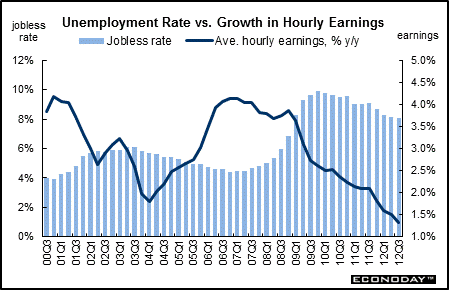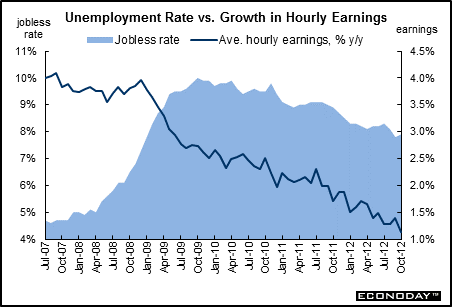| Production & Sales | Inflation | Federal Reserve Policy | Interest Rates |
FEDERAL RESERVE POLICY
Unemployment Rate vs. Growth in Hourly Earnings |
||
Long Term Perspective When the economy is operating at full throttle, a falling unemployment rate worries policymakers as they anticipate that rapidly rising wages will turn into runaway inflation. In fact, wage growth did accelerate in 2005 and over most of 2006 as the jobless rate headed lower. But the reverse has been true during the past recession and early recovery. A rising jobless rate often alleviates wage pressures but is typically associated with economic recession. Federal Reserve policymakers aim for balanced growth with very low inflation.
Short Term Perspective The unemployment rate rose sharply over the latest recession and even into early economic recovery. At the business cycle peak in December 2007, the unemployment rate had already risen by just over half a percentage point to 5.0 percent from the cycle low of 4.4 percent. Job weakness accelerated during 2008 as the unemployment rate jumped to 7.4 percent in December 2008. Conditions worsened even further in 2009 as the unemployment hit a 10.0 percent in October 2009—the cycle peak and highest rate since mid-1983. With moderate economic growth during the recovery, the unemployment rate hit a recent low of 7.8 percent in September 2012 but nudged back up to 7.9 percent in October 2012.
Average hourly earnings have eased from the cyclical peak. Wage growth has been on a downtrend since late 2006. The year-ago pace in October 2012 came in at 1.1 percent, compared to 1.4 percent the prior month. This latest compares to 4.22 percent (other months round to 4.2 percent but are not as high at higher decimal precision) for the cycle peak set in December 2006. The soft wage rate is seen by many members of the FOMC as allowing continued easy monetary policy.
|
||

